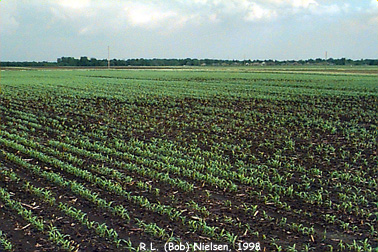Keep an Eye on Those Corn
Plants!
 R.L. (Bob) Nielsen ,
Agronomy Department ,
Purdue University, West Lafayette, IN
47907-1150
R.L. (Bob) Nielsen ,
Agronomy Department ,
Purdue University, West Lafayette, IN
47907-1150
Internet address: rnielsen@purdue.edu
By now, you probably have most of your corn in the ground, some for
maybe the second time. If it has not emerged yet, it will soon.
Stand establishment
uniformity and vigor play an important role in determining the
ultimate yield potential for a field. Mixtures of gaps and crowded plants
can easily decrease yields by 5 to 7 ½ bushels per acre. Uneven
emergence can result in yield losses of 8 to 20 percent.
Take the time to walk fields during the next week or two and take
thorough notes on stand establishment problems that may exist. Here's a
checklist for note-taking.
- Are the plant-to-plant
spacings uniform or variable? If variable, try to determine
whether the cause is related to planter accuracy (gaps, doubles, both)
or simply stand loss from pests or weather (gaps).
- Are the plant
populations equal to your pre-planting objective? If too high, the
blame lies with the planter and/or the planter operator. If too low, the
culprit may still be the planter but more likely is related to pest or
weather factors.
- Shortly after emergence (1- to 2-leaf collar stage), assess the
uniformity of plant development and use it as a gauge for the uniformity
of emergence. If the overwhelming majority of the plants are the same
leaf stage, treat yourself to coffee and donuts at the Chat 'n Chew Café.
On the other hand, if there is a great deal of
variability among the
plants for leaf stage, it is likely an indicator that emergence
did not occur uniformly. The primary cause of uneven emergence is
usually variable soil moisture in the seed zone, but variable soil
temperature and seed-to-soil contact can also play important roles. Poor
seed-to-soil contact could easily have occurred in
cloddy seed beds planted in
recent weeks.
- After about the 5-leaf collar stage of development, assess the
uniformity of plant growth and development across the field. If all the
plants are uniform height and color, treat yourself to coffee and donuts
at the Chat 'n Chew Café. If uneven, try to determine whether to
blame variable emergence (see previous bullet) or subsequent variable
growth and development. The latter is likely caused by one or more
factors that are restricting root development (variable soil moisture or
temperature, soil compaction, or injury from certain herbicides, insects
or diseases). At this point in 1998, common culprits include
ponded or simply
saturated areas of fields and soil compaction.
If you are into site-specific crop management, then recording and
mapping GPS-based information relative to stand establishment uniformity
and vigor will be time well-spent when it comes around to interpreting
yield data after harvest this fall. Problems with stand establishment
commonly influence final yield, yet are also commonly overlooked at the
end of the season when trying to perform a "post-mortem"
analysis of low or variable yields.

For other information about corn, take a look at
the Corn Growers Guidebook on the World Wide Web at
http://www.agry.purdue.edu/ext/corn/
End of Document
 R.L. (Bob) Nielsen ,
Agronomy Department ,
Purdue University, West Lafayette, IN
47907-1150
R.L. (Bob) Nielsen ,
Agronomy Department ,
Purdue University, West Lafayette, IN
47907-1150